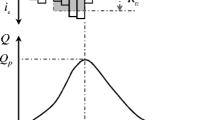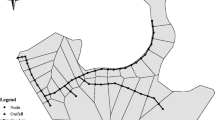Abstract
Taiwan frequently experiences heavy rainfall events during the summer. The rainfall–runoff regeneration is an important job in specific areas where excessive rainfall causes serious flooding. The primary goal of this study is to generate and understand runoff components of the watershed outlet by using a conceptual model of three linear cascade reservoirs. The conceptual model is needless to determine direct runoff and excess rainfall in advance. Every linear cascade reservoir has an independent response function with an exponential expression. The outflows of the linear reservoirs represent streamflow components of a watershed outlet during rainfall–runoff processes, in which surface runoff is considered as quick runoff, whereas subsurface and groundwater runoffs are slow runoffs. In the simulation process, mean rainfall as model inputs were estimated using the block Kriging method. Available recordings of 68 rainfall–runoff events during 1966–2002 were used as the study sample. Fifty-four events were calibrated to determine the best hydrograph parameters and were used to compare simulation precision resulting from the model with those based on the Nash with NLP. The efficacy of the proposed model was verified using the remaining 14 observed rainfall–runoff data from an actual basin. The seven averaged parameters, which were applied for verification, show that the IUH shape of quick flow is more sharp-pointed with the peak shifted forward than that of slow flow. In rainfall–runoff processes, peak discharge of quick runoff is far larger than that of slow runoff, the time it takes for the peak discharge for a quick flow is earlier than that for a slow runoff, and the base time of a slow flow is longer than that of a quick flow. Furthermore, this study also found: (1) the base time of a slow runoff hydrograph is the same as that of a total runoff hydrograph; (2) the base time of a quick runoff hydrograph is contrariwise to the value of the soil antecedent moisture; (3) an amount of quick runoff is directly proportional to that of total runoff. These analytical results reveal that the model used in this study is suitable to evaluate hydrological conditions in this and other watersheds and can be further applied to watershed management in Taiwan.
Similar content being viewed by others
References
Agirre U, Goñi M, López JJ, Gimena FN (2005) Application of a unit hydrograph based on subwatershed division and comparison with Nash’s instantaneous unit hydrograph. Catena 64:321–332
Ahmad MM, Ghumman AR, Ahmad S (2009) Estimation of Clark’s instantaneous unit hydrograph parameters and development of direct surface runoff hydrograph. Water Resour Manag 23:2417–2435
Bastin G, Lorent B, Duque C, Gevers M (1984) Optimal estimation of the average rainfall and optimal selection of raingauge locations. Water Resour Res 20:463–470
Beven KJ, Kirkby MJ (1979) A physically based, variable contributing area model of basin hydrology. Hydrol Sci Bull 24:43–69
Bhadra A, Bandyopadhyay A, Singh R, Raghuwanshi NS (2010) Rainfall–runoff modeling: comparison of two approaches with different data requirements. Water Resour Manag 24:37–62
Campling P, Gobin A, Beven K, Feyen J (2002) Rainfall–runoff modelling of a humid tropical catchment: the TOPMODEL approach. Hydrol Process 16:231–253
Chen RS, Pi LC, Huang YH (2003) Analysis of rainfall–runoff relation in paddy fields by diffusive tank model. Hydrol Process 17:2541–2553
Cheng SJ, Wang RY (2002) An approach for evaluating the hydrological effects of urbanization and its application. Hydrol Process 16:1403–1418
Cheng SJ, Hsieh HH, Wang YM (2007) Geostatistical interpolation of space–time rainfall on Tamshui River Basin, Taiwan. Hydrol Process 21:3136–3145
Cheng KS, Lin YC, Liou JJ (2008a) Rain-gauge network evaluation and augmentation using geostatistics. Hydrol Process 22:2554–2564
Cheng SJ, Hsieh HH, Lee CF, Wang YM (2008b) The storage potential of different surface coverings for various scale storms on Wu-Tu watershed, Taiwan. Nat Hazards 44:129–146
Chow VT, Maidment DR, Mays LW (1988) Applied hydrology. McGraw-Hill, New York
Clarke RT (1973) A review of some mathematical models used in hydrology, with observations on their calibration and use. J Hydrol 19:1–20
Dooge JCI (1959) A general theory of the unit hydrograph. J Geophys Res 64:241–256
Duan J, Miller NL (1997) A generalized power function for the subsurface transmissivity profile in TOPMODEL. Water Resour Res 33:2559–2562
Duan Q, Gupta VK, Sorooshian S (1993) Shuffled complex evolution approach for effective and efficient global minimization. J Optim Theory Appl 76:501–521
Ford DT, Morris EC, Feldman AD (1980) Corps of Engineers experience with automatic calibration of a precipitation–runoff model. In: Haimes Y, Kindler J (eds) Water and related land resources systems. Pergamon, New York, pp 467–476
Franchini M, O’Connell PE (1996) An analysis of the dynamic component of the geomorphologic instantaneous unit hydrograph. J Hydrol 175:407–428
Freer JE, McMillan H, McDonnell JJ, Beven KJ (2004) Constraining dynamic TOPMODEL responses for imprecise water table information using fuzzy rule based performance measures. J Hydrol 291:254–277
Geetha K, Mishra SK, Eldho TI, Rastogi AK, Pandey RP (2008) SCS-CN-based continuous simulation model for hydrologic forecasting. Water Resour Manag 22:165–190
Goovaerts P (2000) Geostatistical approaches for incorporating elevation into the spatial interpolation of rainfall. J Hydrol 228:113–129
Green WH, Ampt GA (1911) Studies on soil physics. J Agric Sci 4:1–24
Hashino M, Yao H, Yoshida H (2002) Studies and evaluations on interception processes during rainfall based on a tank model. J Hydrol 255:1–11
Horton RE (1940) An approach toward physical interpretation of infiltration capacity. Proc Soil Sci Soc Am 5:399–417
Hsieh LS, Wang RY (1999) A semi-distributed parallel-type linear reservoir rainfall–runoff model and its application in Taiwan. Hydrol Process 13:1247–1268
Huang HJ, Cheng SJ, Wen JC, Lee JH (2008a) Effect of growing watershed imperviousness on hydrograph parameters and peak discharge. Hydrol Process 22:2075–2085
Huang SY, Cheng SJ, Wen JC, Lee JH (2008b) Identifying peak–imperviousness–recurrence relationships on a growing-impervious watershed, Taiwan. J Hydrol 362:320–336
Jin CX (1992) A deterministic gamma-type geomorphologic instantaneous unit hydrograph based on path types. Water Resour Res 28:479–486
Kadoya M, Tanakamara H (1988) Flood runoff forecasting with long and short terms runoff model. Proceedings of the 6th APD Congress, International Association for Hydraulic Research, Kyoto, Japan, July, pp 20–22
Kliment Z, Matoušková M (2009) Runoff changes in the Šumava Mountains (Black Forest) and the Foothill Regions: extent of influence by human impact and climate change. Water Resour Manag 23:1813–1834
Lebel T, Bastin G (1985) Variogram identification by the mean squared interpolation error method with application to hydrologic field. J Hydrol 77:31–56
Lee YH, Singh VP (1999) Tank model using Kalman filter. J Hydrol Eng 4:344–349
Lee YH, Singh VP (2005) Tank model for sediment yield. Water Resour Manag 19:349–362
Legates DR, McCabe Jr GJ (1999) Evaluating the use of “goodness-of-fit” measures in hydrologic and hydroclimatic model validation. Water Resour Res 35:233–241
Madsen H (2000) Automatic calibration of a conceptual rainfall–runoff model using multiple objectives. J Hydrol 235:276–288
Maidment DR (ed) (1993) Handbook of hydrology. McGraw-Hill, New York
Mays LW, Taur CK (1982) Unit hydrographs via nonlinear programming. Water Resour Res 18:744–752
Melone F, Corradini C, Singh VP (1998) Simulation of the direct runoff hydrograph at basin outlet. Hydrol Process 12:769–779
Moramarco T, Melone F, Singh VP (2005) Assessment of flooding in urbanized ungauged basins:a case study in the upper Tiber area, Italy. Hydrol Process 19:1909–1924
Nash JE (1957) The form of the instantaneous unit hydrograph. IAHS Publ 45:112–121
Nash JE, Sutcliffe JV (1970) River flow forecasting through conceptual models: 1. A discussion of principles. J Hydrol 10:282–290
Nayak PC, Sudheer KP, Ramasastri KS (2005) Fuzzy computing based rainfall–runoff model for real time flood forecasting. Hydrol Process 19:955–968
Nourani V, Singh VP, Delafrouz H (2009) Three geomorphological rainfall–runoff models based on the linear reservoir concept. Catena 76:206–214
O’Connell PE, Todini E (1996) Modelling of rainfall, flow and mass transport in hydrological systems: an overview. J Hydrol 175:3–16
Parhi PK, Mishra SK, Singh R (2007) A modification to Kostiakov and modified Kostiakov infiltration models. Water Resour Manag 21:1973–1989
Philip JR (1957) The theory of infiltration: 1. The infiltration equation and its solution. Soil Sci 83:345–357
Ponce VM (1980) Linear reservoirs and numerical diffusion. J Hydraul Div 106:691–699
Ponce VM (1989) Engineering hydrology: principles and practices. Prentice Hall, Englewood Cliffs
Ponce VM, Hawkins RH (1996) Runoff curve number: has it reached maturity? J Hydrol Eng 1:11–19
Ponce VM, Cordero-Brana OI, Hasenin SY (1997) Generalized conceptual modeling of dimensionless overland flow hydrographs. J Hydrol 200:222–227
Ponce VM, Lindquist DS (2007) Management of baseflow augmentation: a review. J Am Water Resour Assoc 26:259–268
Potter KW (2001) A simple method for estimating baseflow at ungaged locations. J Am Water Resour Assoc 37:177–184
Poulovassilis A, Elmaloglou S, Kerkides P, Argyrokastritis I (1989) A variable sorptivity infiltration equation. Water Resour Manag 3:287–298
Rao AR, Tirtotjondro W (1995) Computation of unit hydrographs by a Bayesian method. J Hydrol 164:325–344
Scanlon TM, Raffensperger JP, Hornberger GM (2000) Shallow subsurface storm flow in a forested headwater catchment: observations and modeling using a modified TOPMODEL. Water Resour Res 36:2575–2586
Sherman LK (1932) Streamflow from rainfall by the unit-graph method. Eng News Rec 108:501–505
Sohail A, Watanabe K, Takeuchi S (2008) Runoff analysis for a small watershed of Tono Area Japan by back propagation artificial neural network with seasonal data. Water Resour Manag 22:1–22
Sugawara M (1979) Automatic calibration of the tank model. Hydrol Sci Bull 24:375–388
Sugawara M (1995) Tank model. In: Singh VP (ed) Computer models of watershed hydrology. Water Resources, Littleton
Syed KH, Goodrich DC, Myers DE, Sorooshian S (2003) Spatial characteristics of thunderstorm rainfall fields and their relation to runoff. J Hydrol 271:1–21
Valeo C, Moin SMA (2000) Variable source area modelling in urbanizing watersheds. J Hydrol 228:68–81 (TOPURBAN 4–5 parameters)
Venkata RK, Eldho TI, Rao EP, Chithra NR (2008) A distributed kinematic wave–Philip infiltration watershed model using FEM, GIS and remotely sensed data. Water Resour Manag 22:737–755
Yue S, Hashino M (2000) Unit hydrographs to model quick and slow runoff components of streamflow. J Hydrol 227:195–206
Zhang Q, Werner AD (2009) Integrated surface–subsurface modeling of Fuxianhu Lake Catchment, Southwest China. Water Resour Manag 23:2189–2204
Author information
Authors and Affiliations
Corresponding author
Rights and permissions
About this article
Cite this article
Cheng, SJ. Generation of Runoff Components from Exponential Expressions of Serial Reservoirs. Water Resour Manage 24, 3561–3590 (2010). https://doi.org/10.1007/s11269-010-9621-0
Received:
Accepted:
Published:
Issue Date:
DOI: https://doi.org/10.1007/s11269-010-9621-0




